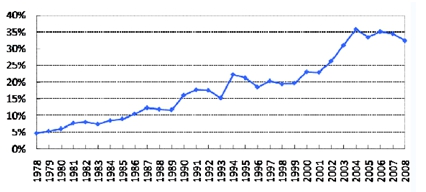Introduction
This paper presents a proposal for the study of export-led growth in Asia. The study’s research question is what is the role of export-led growth in China? In order to answer this question, the study will be guided by the following objectives. The first objective will be to determine the contribution of exports to China’s economic growth and development.
The second objective will be to determine the challenges associated with China’s export-led economic growth strategy. The third objective will be to assess the sustainability of the export-led growth strategy. The last objective will be to evaluate the strategies that China can use to respond to the challenges associated with export-led growth. This proposal will provide a summary of the issues and information about the topic, as well as, the sources that will be used in the study.
Summary of Issues and Information
Supporters of China’s export-led growth strategy believe that the approach has enabled the country to improve its economic fortunes in the last three decades. This perspective is based on the fact that the strategy promoted heavy investment in the country’s manufacturing sector, thereby creating jobs (Yao 1-29).
In addition, the strategy led to increased foreign exchange earnings that enabled China to import the intermediary goods that it required to achieve rapid industrialization. Overall, the strategy boosted economic growth by accounting for nearly 35% of China’s GDP in the last three decades as shown in figure below. This led to reduced poverty levels and improved standards of living in China.

However, the export-led strategy has also been criticized for its negative effects on China’s economy. Specifically, the strategy led to underutilization of domestic savings and overreliance on external demand (Razmi 3-30). In addition, the strategy led to a reduction in domestic consumption and the incomes of households. Given these shortcomings, the export-led strategy is considered unsustainable in China (Akyuz 2-22).
One of the factors that support this perspective is that globalization has increased competition in the international market, thereby reducing export earnings. In this respect, most economists believe that China should boost domestic consumption to spur economic growth (Xing 1-20).
Summary of Sources
Yao (2010) in his study of structural change and demographic transition highlights the contributions of the export-led strategy to China’s economic growth between 1980 and 2008. The study identifies the structural imbalances that the strategy has created in China’s economy.
The study by Razmi (2009) identifies the weaknesses of China’s export-led growth strategy and the factors that caused them. Specifically, it highlights the economic and social problems that have been created by the strategy. The study concludes that the export-led strategy is not sustainable due to its weaknesses.
Akyuz (2011) in his study of the sustainability of economic growth in China identifies the factors that contributed to increased exports in the country. His study indicates that low domestic consumption is the main factor that promotes the export-led growth strategy. The study concludes that domestic consumption should be encouraged by increasing the share of individual and household income in GDP to address the challenges of the export-led strategy.
The study by Xing (2013) discusses the vulnerability created by overreliance on exports in China. Specifically, it highlights the response of China’s economy to negative external shocks during periods of economic downturn. The study concludes that China is yet to rebalance its economy by reducing its dependence on exports. The four studies summarized in the foregoing paragraphs will be used in the proposed research paper.
Conclusion
China has achieved a rapid economic growth due to increased exportation of various goods and services. However, the export-led growth strategy has also created structural challenges such as reduced domestic consumption. Thus, the strategy is considered unsustainable and should be replaced with a consumption-led growth model.
Works Cited
Akyuz, Yilmaz. “Export Dependence and Sustainability of China.” China and World Economy 19.1 (2011): 2-22. Print.
Razmi, Arslan. Is the Chinese Investment and Export-led Growth Model Sustainable? Some Rising Concerns. Academic. Amherst: Unversity of Massachusetts, 2008. Print.
Xing, Yuquing. How Important is Exports and FDI for China’s Economic Growth? Academic. Tokyo: GRIPS, 2013. Print.
Yao, Yang. The Double Transition and China’s Export-led Growth. Academic. Beijing: China Center for Economic Research, 2010. Print.